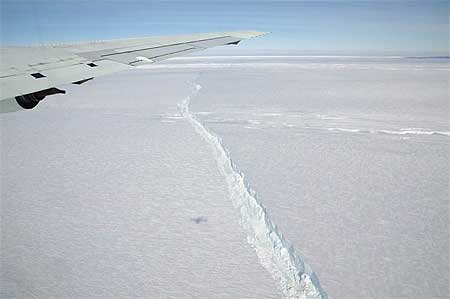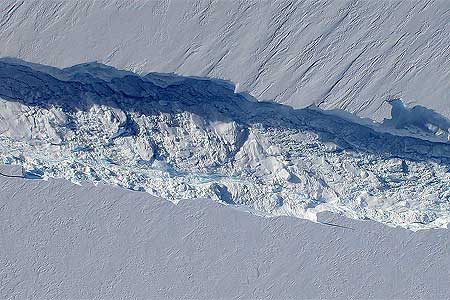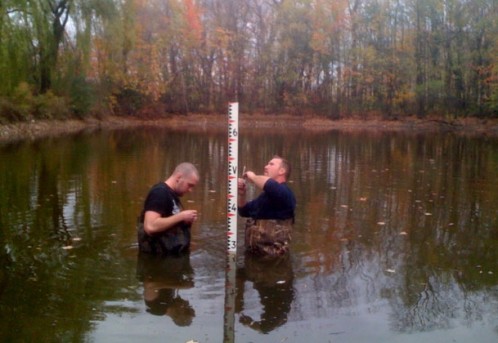News
The Great Blue Norther of 11/11/11
For the 100th Anniversary of one of most noteworthy storms in the history of the Midwest, University of Missouri atmospheric science students Brian Crow, Evan Kutta, and Jennifer Power spent hours digging through historical records. They were trying to document the progress of the Great Blue Norther of 11 November 1911, tracking the situation through old newspaper articles and other documents. What they found showed how devastating weather can be when people have no warning, as a beautiful, sunny and warm fall day quickly turned into a deadly winter blast including tornadoes and derechoes.
Using the information about the impact of the storm, along weather data and reanalyses, UM Associate Professor Patrick Market reconstructed the storm and found a relatively close modern analog–29 January 2008. That storm had a slower but similar temperature drop (from 70°F to 15°F) and a similarly intense cold front.
Check out the interactive map the students created that tracks the events of that fateful day 100 years ago
View 11/11/1911 in a larger map
Jack Townsend, Shepherd of Weather Satellite Technology
The passing of AMS Fellow John W. (“Jack”) Townsend on October 29 serves as a fitting moment to register the evolving national relationship with space technology over six decades.
“Jack Townsend was truly one of the seminal figures in the history of NASA, and certainly, in the history of Goddard,” said current Goddard Spaceflight Institute Director Rob Strain. “The story of the space program simply could not be written without a chapter devoted to him. He dedicated his life to the exploration of space and the study of our planet, and humankind is richer for the knowledge he helped generate.”
Townsend was one of the first employees at Goddard in 1959, where he directed the satellite applications efforts, at a time when the nation was racing to enter the Space Age. He had already cut his teeth on space technology, first in radar countermeasures aboard B-29 bombers in World War II and, by 1949, working with V-2 rockets. Townsend helped bring satellite meteorology to fruition in the 1960s as Deputy Administrator of the Environmental Science Services Administrator (predecessor to today’s NOAA). After a decade at Fairchild Industries, he returned to NASA after the Challenger disaster, and then for three years as Director of Goddard.
Townsend retold the story of the origins of weather satellites just a year ago in an interview with archivist/historian Doria Grimes:
[E]verything started with sounding rockets just after World War II. I went to work for the Naval Research Laboratory (NRL) following my graduate degree in physics. The sounding rocket program had just started at NRL and it involved the Army, Navy, and Air Force…. Interestingly enough, at White Sands, New Mexico, we flew rockets out over the desert in the late 1940’s. We put cameras on them called gun sight aiming point cameras, “GSAPs”. The idea of the camera was that as the rocket went up and rotated, it took pictures of the earth in swaths. You would use those pictures to reconstruct the attitude of the rocket.
One day we had a shot in New Mexico in which we caught what looked like a storm in pictures off to the southeast. One of the guys who worked for me, Otto Berg, made a composite picture of nearly 1,000 tiny GSAP pictures, a total mosaic of a storm. It looked exactly like a hurricane, and attracted the Weather Bureau’s attention. It was in the early 50’s – all before Sputnik.
The pictures stirred interest from Harry Wexler at the Weather Bureau, and eventually a classified Army satellite project was moved into the new NASA, gradually became declassified, leading to the first weather satellite, TIROS. It was during this period that Townsend and other American science administrators were involved with negotiating peaceful uses of space technology with their Soviet counterparts.
The subject came up of transferring data. We, at that time, expected to launch the research meteorological satellites. They promised they were going to launch meteorological rockets and satellites. Incidentally, they never did. But they wanted the transferred data because Russian ground data was very sparse, and these data meant a lot to them as a country. With the free transfer of meteorological data and satellite pictures, we had an issue, a big issue. Who pays for the communication expenses between Washington and Moscow? We got into a big fight about that, and the agreement had been to share. The Russians said that since the U.S. owns all these communications facilities, the U.S. should pay for 90% of it. Then the Russians said that the ruble was not worth as much money as the dollar. Finally, I came up with one of the only brilliant ideas I ever came up with. I said sharing means 50/50. We’ll pay the bill for three months, and you pay it for three months….So I cut this deal with the Russians on how to pay for it. [His Russian negotiating counterpart] Blagonravov thought it was funny. He laughed, and said to me, “I am glad I am too old to send to Siberia.” He was a lieutenant general which is a five star rank in those days, and he also was a communist and believed in the system. He was a neat guy and I got to like him.
The whole interview (transcript here) has more on the origins of the space program, NOAA, and operationsl satellites. You’ll get the sense that the field was guided then by strong personalities and a country committed to technology. [For more on the early development of weather satellites, specifically TIROS, check out James Rodger Fleming’s presentation on “Transformative Technologies and International Cooperation in the Career of Harry Wexler” at the 2012 AMS Annual Meeting (11 a.m., Tuesday 24 January)].
Latest Readings
From our AMS bookmarks this week (for more, visit AMSFrontPage on Delicious, http://bit.ly/v7dMY2): Sun trackers gather to calibrate instruments…Feds make slow progress on levee inventory…WoW! FIU’s New Hurricane Simulator…Terra, Landsat Among US Satellites Hacked…Rivers Exhaling Surprising Amounts of Carbon Dioxide…Arkansas observers honored for 75 years of weather data…Obama Setting Records for Disaster Declarations…New NCAR supercomputer a boon for Wyoming wind energy studies
NASA Mission Monitors Birth of Antarctic Iceberg
Resuming a multi-year mission to map Antarctic ice in mid October, NASA researchers discovered a miles-long crack in a major glacier that marks the beginning of a new mammoth iceberg. Operation IceBridge scientists flying in a specially instrumented DC-8 jet returned soon after to make the first-ever detailed airborne measurements of giant iceberg calving in progress.
The crack in Pine Island Glacier, which extends at least 18 miles (29 km) and is 165 feet (50 meters) deep—enough to swallow up the Statue of Liberty— could break free a chunk of ice more than 340 square miles (880 square km) in size from the vulnerable West Antarctic Ice Sheet.

Pine Island Glacier’s ice shelf mostly floats, extending its unstable arm as many as 30 miles (48 km) away from the Antarctic landmass that grounds it some 500 meters (1,640 feet) below the surface. As the glacial ice inland flows slowly toward the sea and feeds the shelf, the arm eventually breaks, calving huge icebergs.
Pine Island Glacier last calved a significant iceberg in 2001, and some scientists have speculated recently that it was primed to calve again. But until an Oct. 14 IceBridge flight of NASA’s DC-8, no one had seen any evidence of the ice shelf beginning to break apart. Since then, a closer look back at satellite imagery seems to reveal the first signs of the crack beginning to cut across the ice shelf in early October.
“It’s part of a natural process, but it’s pretty exciting to be here and actually observe it while it happens,” says Operation IceBridge project scientist Michael Studinger of NASA’s Goddard Space Flight Center.

The IceBridge team thinks that once the iceberg breaks free, it will leave behind the shortest extending arm of the Pine Island Glacier since recordkeeping began in the 1940s.
Pine Island Glacier is of particular interest to scientists because it is big and unstable, which makes it one of the largest sources of uncertainty in global sea level-rise projections. A collapse of the entire West Antarctic Ice Sheet (WAIS) is one of the nightmare scenarios climate forecasters envision in a warming world. If the WAIS were to melt, it could raise sea levels worldwide 20 feet.
NASA’s Operation IceBridge, the largest airborne survey of Earth’s polar ice ever flown, is in the midst of its third field campaign from Punta Arenas, Chile. The six-year mission will yield an unprecedented three-dimensional view of Antarctic ice sheets, ice shelves, and sea ice.
Gliders Do the Wave, in the Air and in the Ocean
One would think that the time when gliders were considered cutting-edge technology for science would have long passed. Yet this durable technology remains at the forefront of research, even today.
Where daredevil pilots once pushed the boundaries of engine-less flight into the upper reaches of the troposphere to study mountain waves, now the Perian Project looks to send its pilots into the stratosphere–30,000 meters up–in the extreme reaches of mountain-perturbed winds. With a special glider that has a pressurized cabin, organizers of the Perian Project hope to double the world’s sailplane altitude record that they set in 2006 with a different sailplane.
Elizabeth Austin of WeatherExtreme, Ltd. (of Fallbrook, California), the forecast provider for the Perian Project, will speak at the AMS Annual Meeting (Monday 23 January at 5 p.m.) about the high-altitude sailplane flights. Tests of the new, Phase 2 glider will begin in 2012 in California. Austin writes,
This two-seat sailplane is a one-of-a-kind, carbon fiber, pressurized sailplane that will utilize the polar night jet associated with the polar vortex to achieve an altitude of 90,000 feet (27.4 kilometers). The phase two glider has a wing span of 84 feet and will weigh 1,800 pounds loaded with two pilots and equipment. The windows are polycarbonate and do not get brittle at low temperatures. A special drogue chute is being designed that will not degrade rapidly with high levels of ozone exposure.
While piloted sailplanes are basically an extension of the daredevil mountain-wave research that’s been going on since before World War II, robotic devices have also recently been extending the art of research gliding far into the oceans.
You may remember that the cover of the August issue of BAMS featured an underwater glider as part of the article on the Alaska Ocean Observing System. At the upcoming Annual Meeting will be several oceanographic presentations involving the use of ocean gliders–for example here for P. Chu and C.W. Fan on thermocline measurements (Monday, 11:30 a.m.) and here for Phelps et al. on conditions for Arctic ice concentrations (Tuesday, 9:45 a.m. poster session).
Thanks to an open-source contest by Liquid Robotics, Inc., you don’t have to wait for the Annual Meeting to find out what it’s like to use the latest robotic gliders in oceanographic and meteorological observing. As a demonstration of robotic gliders powered by wave action, the Sunnyvale, California, company is launching four of its remote controlled craft in San Francisco on 17 November. Their goal: to cross the Pacific Ocean while collecting a variety of oceanic and atmospheric parameters.
The company is calling this record-breaking robotic the PacX Challenge and it involves a prize for the scientist–that could be you!–who comes up with the best use of the data streaming back from the robots as they make their way westward and, hopefully, avoid sharkbite (which has happened to one of the company’s gliders in the past).
The gliders (featured in today’s New York Times), only move at about one knot or so, and will split into pairs in Hawaii. In about 300 days, one pair is expected to reach Japan; the other pair, Australia.
While at sea, the Wave Gliders will be routed across regions never before remotely surveyed and will continuously transmit valuable data on salinity and water temperature, waves, weather, fluorescence, and dissolved oxygen. This data will be made available in near real-time to all registered individuals.
Oceanographic organizations already planning to use the data gathered during the Pacific crossing include Scripps Institution of Oceanography, Woods Hole Oceanographic Institution, and the Monterey Naval Post Graduate School.
If you submit an abstract by 23 April 2012, you can design a scientific mission for the gliders and hope for this:
The grand prize winner will receive six months of free Wave Glider data services and will work with Liquid Robotics to chart the course and mission for the six month deployment, including configuration of onboard sensors.
Not a bad way to let robots do the work for you.
About That New Satellite
With the the NPOESS Preparatory Project (NPP) satellite launched successfully yesterday from Vandenberg Air Force Base in California, satellite users will want to begin thinking about getting up to date on NPP at the AMS Annual Meeting. Here’s a quick link to the dozens of upcoming AMS Annual Meeting presentations related to the satellite and JPSS in general.
In particular consider attending the Tuesday (24 January,; 8:30 am) panel on “Expected Improvements from Satellite Technology on Operational Capabilities at the NWS, Navy, and Air Force.” The participants are the heads of those respective forecasting agencies–Jack Hayes, Fred Lewis, and James Pettigrew. AMS’s William Hooke moderates.
Also, on Monday (23 January at 11:45 am) Mitchell Goldberg et al. of the JPSS program will describe NPP and its place in the overall JPSS mission (the Joint Polar Orbiting Satellite System, is the civilian-side successor to NPOESS, which was the National Polar-Orbiting Environmental Satellite System). NPOESS was canceled in 2010.
Meanwhile, until we meet in New Orleans, here’s context about how the mission has evolved with the cancellation of the NPOESS. And here’s a NASA video describing NPP’s mission and capabilities:
Further, you’ll find a wealth of information about the NPP satellite and its genesis in the overall architecture of NPOESS, described in BAMS last year. The meeting program has more specifically about the five major instruments aboard, VIIRS (Visible Infrared Imaging Radiometer Suite; described here in BAMS), CriS (Cross-track infrared Sounder), ATMS (Advanced Technology Microwave Sounder), OMPS (Ozone Mapper Profiler Suite), and CERES (Clouds and the Earth’s Radiant Energy System; description in BAMS here).
We’ll undoubtedly post more about specific satellite-related sessions at the 2012 Annual Meeting in New Orleans as we approach January.
Science Run Amuck

Let no one claim that student hydrologists do not gain a deep understanding of their subject. The University of Wisconsin-Parkside press release explains:
Students continue to use the campus environment as a natural laboratory. The latest case of this is the recent installation of a water level gauge in Greenquist Pond by researchers from Geosciences Professor John Skalbeck’s Environmental Sampling, Monitoring, and Assessment (GEOS 445) course.
Students Jacob Jazefowski, left in the above photo, and John Rasch pulled on hip waders and immersed themselves in their research work. Greenquist Pond will soon be filled and the gauge they installed will monitor future pond water levels.
Students in this course are assessing groundwater levels from campus monitoring wells and measuring water quality in the pond and in the Pike River. They are investigating wetland soils, vegetation, and hydrology characteristics near the Pike River and in the Willow Swamp near the campus’ Wood Road entrance and are evaluating the potential for additional rain gardens to capture storm water from Ranger Hall.
“The different types of soils, water lands, and bodies of water on our campus provide an ideal outdoor laboratory for this course, which is highly experiential-based,” Skalbeck said.
Python in New Orleans: Once Bitten, Quickly Smitten
The upcoming 2012 AMS Annual Meeting in New Orleans is only the second with a whole symposium devoted to the use of Python programming language in the atmospheric sciences. The first was last year’s meeting in Seattle.
The quick return of Python to the conference program–including beginning and advanced short courses over the weekend (21-22 January)–suggests what a growing community of modelers and programmers already knows. Once they’ve encountered the Python language, people tend to become devotees.
“Python is an elegant and robust programming language that combines the power and flexibility of traditional compiled languages with the ease-of-use of simpler scripting and interpreted languages,” according to Filipe Pires Fernandes of the School of Marine Science and Technology in New Bedford, Massachusetts, who presents Monday (23 January, 2 p.m.).
Python, for example, is at the heart of the National Weather Service’s graphical forecast editor (GFE) tool and thus at the basis of the usage of the whole gridded forecast product suite in effect over the last decade. “Python’s introspective capabilities permitted developers to build a tool framework in which forecasters could write simple expressions and apply them directly to the forecast process without the burden of needing to know details about data structures or user interfaces,” writes Thomas LeFebvre of NOAA, who will discuss (Tuesday, 24 January, 8:30 am) how “a large part of GFE’s success is the result of the rich set of features that Python offers.”
Symposium Chair Johnny Lin of North Park University produced a short video to explain the attraction of Python, now the “eighth most popular programming language in the world” and preview the upcoming symposium:
The symposium program features numerous new software packages, with many of the presentations demonstrating how Python is a solution to software quirks and limitations that have become more bothersome as technology advances. One presenter is using Python to display data and model output on Google Earth. Another developed a new Skew-T diagram and Hodograph visualization and research tool (SHARPY), recasting a standard program, SHARP, in Python. Explains Patrick Marsh of NOAA’s National Severe Storms Laboratory: “Unfortunately, SHARP utilizes several GEMPAK routines which makes compiling, let alone installing and using, a non-trivial task.”
Andrew Charles of the Bureau of Meteorology in Australia used Python to create a web-based tool to integrate contour plotting with GIS applications. “With ever increasing amounts of data being made available, the related increase in required storage means static plots are not a viable solution for the delivery of all maps to end users,” writes Charles about his (11:30 a.m. Tuesday) presentation. “Contour plots are one of the most used data visualisation techniques in meteorology and oceanography and yet, surprisingly, there are few available solutions for the generation of contour plots to be used as map overlays from live data sources.”
UCAR's Next President, Thomas Bogdan

The University Corporation for Atmospheric Research (UCAR) announced today that Thomas Bogdan will succeed Richard Anthes as its next president, beginning in January 2012.
Bogdan has been director of the National Oceanic and Atmospheric Administration’s Space Environment Center in Boulder, Colorado, since 2006. A Fellow of the AMS and current member of our Council, Bogdan moved to NOAA after a long stint at UCAR’s National Center for Atmospheric Research, beginning as a post-doc, moving up through the Scientist and administrative ranks, and eventually serving as Acting Director of NCAR’s Advanced Studies Program. From 2001-2003 Bogdan was Program Director for the National Science Foundation’s Solar-Terrestrial Research Section. He received his Ph.D. in physics at the University of Chicago in 1984.
You can hear a recent interview with Bogdan about space weather on Colorado Public Radio.
Or watch his presentation about space weather from 2007 at the Commercial Space Transportation Conference: